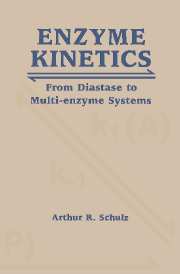Book contents
- Frontmatter
- Contents
- Preface
- Part One Basic steady state enzyme kinetics
- 1 Derivation of a rate equation
- 2 A closer look at the basic assumptions
- 3 Enzyme inhibition
- 4 Reversible enzyme-catalyzed reactions
- Part Two Enzyme reaction sequence
- Part Three Non-hyperbolic enzyme kinetics
- Part Four Control of multi-enzyme systems
- Part Five Solutions To problems
- Author index
- Subject index
1 - Derivation of a rate equation
Published online by Cambridge University Press: 23 November 2009
- Frontmatter
- Contents
- Preface
- Part One Basic steady state enzyme kinetics
- 1 Derivation of a rate equation
- 2 A closer look at the basic assumptions
- 3 Enzyme inhibition
- 4 Reversible enzyme-catalyzed reactions
- Part Two Enzyme reaction sequence
- Part Three Non-hyperbolic enzyme kinetics
- Part Four Control of multi-enzyme systems
- Part Five Solutions To problems
- Author index
- Subject index
Summary
Enzymes do not make reactions take place, they stimulate the rate at which reactions do take place. Any chemical reaction which proceeds in the presence of an enzyme will also proceed in the absence of the enzyme but at a much slower rate. Enzymes catalyze the rate of chemical reactions by lowering the activation energy of the reaction, and they do this in a manner which is highly specific for the reactants of the reaction. It was realized very early in the study of enzyme action that meaningful studies of enzyme action would, of necessity, involve the study of the kinetic behavior of the chemical reaction in the presence of the appropriate enzyme. It is still true that if one understands the kinetic behavior of the enzyme-catalyzed reaction, one also understands much about the mechanism of the enzymic reaction. This requires the investigation of the kinetic behavior of the enzymic reaction under conditions which are defined meticulously. Within the framework of this text, this will imply under steady state conditions. Steady state, as it applies to enzyme kinetics will be defined in this chapter and in chapter 2.
The role of ‘diastase’ in the early development of a theory
The enzyme-catalyzed hydrolysis of sucrose played an important role in the early development of a suitable equation to explain the kinetic behavior of enzyme-catalyzed reactions. One reason for the importance of this reaction was that the enzyme invertase was available in a reasonably pure form by the end of the nineteenth century when the principles of enzyme kinetics were established. In some of the early literature, this enzyme was called diastase.
- Type
- Chapter
- Information
- Enzyme KineticsFrom Diastase to Multi-enzyme Systems, pp. 3 - 21Publisher: Cambridge University PressPrint publication year: 1994
- 1
- Cited by



